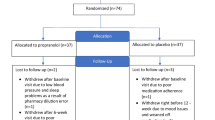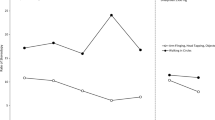Abstract
We began open trials of beta-blockers, as adjunctive medication, in eight consecutive autistic adults. The immediate result across all patients was a rapid diminution in aggressivity (Ratey et al., 1987). As time on the drug increased, subtler changes in speech and socialization emerged. While results of open trials must be interpreted with caution, these changes were significant and lasting. We speculate that these effects may be the result of a lessening of the autistic individual's state of hyperarousal. As the individual becomes less anxious, defensive and dearousing behaviors are relinquished and more social and adaptive behaviors appear. There is a concomitant improvement in language, though it is unclear whether lost skills are recouped or new ones developed. Further research is indicated.
Similar content being viewed by others
References
Bemporad, J. (1979). Adult recollections of a formerly autistic child.Journal of Autism Developmental Disorders, 9, 179–197.
Bowlby, J. (1969).Attachment and loss: Attachment. London: Hogarth Press.
Cohen, D. J. (1980). The pathology of the self in primary childhood autism and Gilles de la Tourette's syndrome.Psychiatric Clinics of North America, 3, 383–402.
Delius, J. D. (1960). Displacement activities and arousal.Nature, 214, 1259–1260.
Eisenberg, L. (1956). The autistic child in adolescence.American Journal of Orthopsychiatry, 112, 607–612.
Greendyke, R., & Kanter, D. (1986). Therapeutic effects of pindolol on behavioral disturbances associated with Organic Brain Disease: A double-bind study.J. Clin Psychiat, 47, 423–426.
Greendyke, R., Schuster, D., & Wooton, J. (1984). Propranolol in the treatment of assaultive patients with organic brain disease.Journal of Clinical Psychopharmacology, 2, 282–285.
Kanner, L., (1943). Autistic disturbances of affective contact.Nervous Child, 2, 217–250.
Kanner, L., (1971). Follow-up study of eleven autistic children originally reported in 1943. Originally reported inJournal of Autism and Childhood Schizophrenia, 1, 119–145.
Kanner, L., & Eisenberg, L. (1955). Notes on the follow-up of autistic children. In P. Hoch & J. Zubin (Eds.),Psychopathology of childhood. New York: Grune & Stratton.
Kinsbourne, M. (1980). Do repetitive behavior patterns in children and animals serve a dearousing function?Journal of Developmental and Behavioral Pediatrics, 1, 39–42.
Kolvin, I. (1970).Psychoses in childhood—a comparative study. Colloquim on Infantile Autism. London: Ciba Foundation.
Lotter, V., (1978). Follow-up studies. In M. Rutter & E. Schopler (Eds.),Autism: A. Reappraisal of Concepts and Treatments. New York: Plenum Press.
Mattes, J. A., Rosenberg, J., & Mays, D. (1984). Carbamazepine vs propranolol in patients with uncontrolled rage outbursts: a random assignment study.Psychopharmacology Bulletin, 20(1), 98–100.
Piaget, J., & Inhelder, B. (1969).The psychology of the child. New York: Basic Books.
Polakoff, S., Sorgi, P., & Ratey, J. J. (1986). The treatment of impulsive aggressive behavior with nadolol.Journal of Clinical Psychopharmacology, 2(6), 114.
Ratey, J. J., Mikkelsen, E., Smith G. B.et al. (1986). Betablockers in the severely and profoundly mentally retarded.Journal of Clinical Psychopahrmacology, 2(6), 103–107.
Ratey, J. J., Mikkelsen, E., Sorgi, P.,et al. (1987). Autism: The treatment of aggressive behaviors.Journal of Clinical Psychopharmacology, 7(1), 35–41.
Rutter, M. (1970). Autistic children: Infancy to adulthood.Seminars in Psychiatry, 2, 435–450.
Rutter, M. (1978). Diagnosis and definition. In M. Rutter & E. Schopler (Eds.),Autism: A Reappraisal of Concepts and Treatment. New York: Plenum Press.
Rutter, M. (1983). Cognitive deficits in the pathogenesis of autism.Journal of Child Psychology and Psychiatry, 24, 513–531.
Sands, S., & Ratey, J. J. (1986). The concept of noise.Psychiatry, 49, 290–297.
Volkmar, F. R., & Cohen, D. J. (1985). The experience of infantile autism: A first-person account by Tony W.Journal of Autism and Developmental Disorders, 15, 47–54.
Author information
Authors and Affiliations
Rights and permissions
About this article
Cite this article
Ratey, J.J., Bemporad, J., Sorgi, P. et al. Brief report: Open trial effects of beta-blockers on speech and social behaviors in 8 autistic adults. J Autism Dev Disord 17, 439–446 (1987). https://doi.org/10.1007/BF01487073
Issue Date:
DOI: https://doi.org/10.1007/BF01487073




